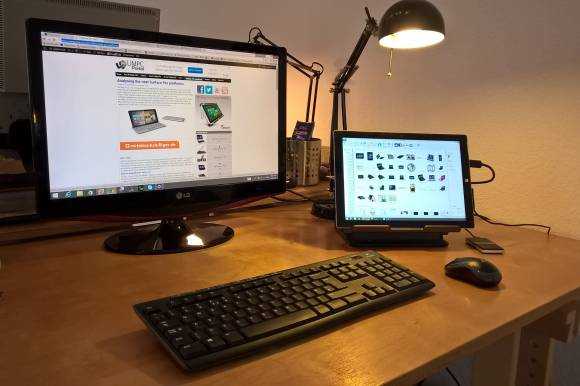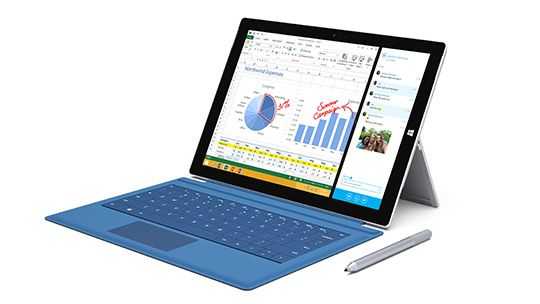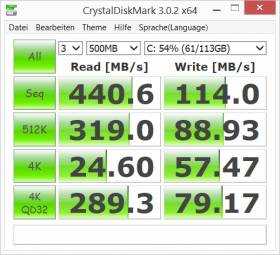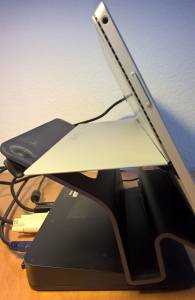It was last September when my Ultrabook screen went blank and never came back. I was gutted; Not only because it was my favourite PC but because I was half-way through reporting on the IFA trade-show and I had a flight to the IDF conference 2 days later. Thanks to Intel Germany I flew out with a Surface Pro 3 and the more I use this incredibly well-designed tablet PC, the more I like it. It’s not my main PC though and I thought I would take the time to explain where the Surface Pro 3 fits into the life of someone who is literally surrounded by touch-screen tablets, laptops and mini PCs. The Surface Pro 3 has taken on the important role of being my hot-desking PC.
The Surface Pro 3 is a powerful lightweight Windows tablet PC with touch and digitizer but I find myself loving the Surface Pro 3 simply because it’s a lightweight mobile PC that I can dock at home and in my co-working office [A big shout out to my Coworking Bonn buddies] and one that I can use for meetings, in the coffee shop and in the bus home if I need to. Apart from the lack of 3G/4G the Surface Pro 3 is one of the most ultra-mobile, work-anywhere PCs I’ve ever used.
Let me start by reviewing the Type Cover keyboard. This bouncy slice of mechanics feels strange, unlike any keyboard I’ve ever used and yet it’s productive. It has a backlight too! It snaps willingly to the tablet and is the perfect demonstration of how a tablet can turn into a laptop. Almost. The biggest issue with this setup is the area required to hold it stable. A laptop requires the area under keyboard; The Surface Pro requires an extra 200 mm behind it for the stand. It’s this huge area that will cut your productivity over a standard laptop if you rely on ‘lap-toping.’ I tried it for a few keynotes and press events and wasn’t happy with stability. Despite that the stand is worth having and after 4 months using the stand I don’t have any sign that the mechanics are wearing out.
The Surface Pro 3 is an expensive hot-desker. $780 buys you a Core i3, 64GB, digitizer-capable tablet but if you don’t need the pen-layer you might not be getting best value for your money. Prices for Ultrabooks have come down recently and a when I look at devices like the Dell XPS 13 (2015 version with Broadwell) I see more battery life, a bigger screen, a better keyboard and more processing power for the same money and just 10% more weight. The Core-M mobile PCs are looking good too. The Lenovo Yoga 3 11 and ASUS Transformer Book T300 Chi are around the same weight and the Acer Aspire Switch 12 is entering the market at just $699. There’s no digitizer on the Acer Aspire Switch 12 and it’s not as powerful as the Surface Pro 3 but it’s much cheaper and arguably more suited to being docked as you can use the Bluetooth keyboard and pointer. Many of these Core M options are fanless too and that makes a difference in a quiet office.
The Surface Pro 3 isn’t loud in normal use but I occasionally hear the sound of a working background process or a heavyweight web page. When I’m rendering my 1080p videos the fan gets almost embarrassingly loud in my co-working office but one can’t moan when it crunches through transcoding with such speed. Quick Sync has come a long way since I first tested it with a 1st-generation Ultrabook in 2011. Handbrake (with Quick Sync support) can now crunch a 1080p 50 FPS 30Mbps file down to 720p at over 200 frames per second!
At this point I should note that I don’t have a digitizer pen but as I have other devices with a digitizer I know that I rarely use such a feature. The only time I really wanted a pen was when I was using the Surface Pro 3 as a whiteboard over Miracast to an Actiontec receiver on a projector. It would have been nice to use One Note as a whiteboard but as it turned out, my finger wasn’t bad either.
While I’m normally mains-power connected I have had reason to worry about battery life. The Intel Developer Forum proved to me that you won’t get through a day without a charger and that, unfortunately, adds weight to the overall package. This is significant as the Ultrabook I was using previously could get through a day meaning that the 1.4KG was all I needed. 200 grams of power supply brings the total tablet/type-cover/power weight to 1.3KG. Looking at the ‘powercfg’ battery report I see that the battery hasn’t worn in the last 4 months at all which indicates that Microsoft have used a good quality battery.
The port choice on the Surface Pro 3 needs consideration. A Mini-DisplayPort is provided for video output and although DP is generally the most flexible it’s not that common to find it on mainstream monitors or projectors. I’m using a DisplayLink video connection (over USB 3.0 via the docking station) which solves that problem but it reduces the quality of graphics and video playback and requires some work from the CPU. That’s not an issue for office-usage but it needs to be mentioned. The docking station also solves the issue of available USB ports. One port isn’t enough for hot-desking if you don’t have a USB hub or USB docking station. Finally there’s the issue of using a MicroSD card slot if your camera uses SD cards. Again, a USB adaptor is required.
- Speakers OK for background music.
- WiFi performance good.
- Looking forward to Windows 10.
- Magnetic power connector good.
- Display colors and brightness is excellent.
- Connected Standby works but isn’t as efficient as it should be.
- Bitlocker encryption (full disk encryption) enabled.
- Miracast works (tested with Actiontec ScreenBeam Pro.)
- Great disk performance.
- Useful USB charging port on the power adaptor.
- Satisfactory 1080p editing (for short, simple YouTube projects) and rendering speed using Cyberlink Power Director 12 and Intel Quick-Sync rendering hardware.
- No NFC. (I have used it extensively for photo transfer in the past.)
Summary
I could use the Surface Pro as my only PC and it makes a fantastic hot-desking solution if you’re prepared to set up a USB 3.0 dock or DisplayPort screen and USB hub but there are two major considerations. 1) The Surface Pro 3 isn’t the best hot-desking solution at the price. Many Ultrabooks would be better as they would offer a better keyboard experience, more ports and larger battery life for a similar weight. The new Dell XPS 13 2015 is the one to watch. 2) The surface Pro 3 isn’t the best casual tablet. It’s too heavy and large.
Where the Surface Pro 3 shines is in flexibility and quality. The Surface Pro 3’s digitizer enables annotations, hover-actions, projected white-board and a digital canvas and there are times when I really wish I had the stylus. [I don’t have it because the SP3 was given to me by Intel without the stylus.] The Surface Pro 3 can handle 1080p video editing. The Surface Pro 3 is a quiet desktop. The Surface Pro 3 can be used in more places than the average laptop. Finally, the Surface Pro 3’s quality is always a pleasure to have to the point where I’m proud to be using it in my co-working space and whenever i’m on the road. It will be my working ‘laptop’ when i’m at MWC and CeBIT in March.
Surface Pro 3 hot-desk details
- Belkin USB 3.0 Dual Video docking stand for Ultrabooks [Amazon.com link]
- MyDigital SSD USB 3.0 external SSD (256GB – often used for windows File History) [Amazon.com link]
- DVI-connected Full HD monitor (LG Flatron M227WDP – Not excellent quality!)
- Gigabit Ethernet connection from docking station
- Logitech MK270 USB keyboard and mouse with long battery life. (RF, not Bluetooth) [Amazon.com link]
Alternatively, without the docking station and monitor I would use a mini USB 2.0 hub, USB Gigabit Ethernet adaptor and a cheap laptop stand.
Surface Pro 4
I’ve written about future Surface Pro platforms before where I highlighted a number of routes to the next Surface Pro products. A smaller, lighter, fanless Surface Pro is possible with Intel Core M or there’s the possibility to improve the SP3 all-round by using a fanless Skylake platform later in 2015. Having a fanless option with wireless charging and WiGi would showcase Skylake well and I think this is the most likely scenario for Surface Pro 4. The Skylake option is something that could be demonstrated in Q3 for Q4 availability. Here’s a rundown of the options.
- 10-inch Core M – Potential to be the most powerful 10-inch tablet in the market. Laptop-replacement CPU performance. Fanless. Could be expensive for the 10-inch category. Untested market. Not as powerful as Surface Pro 2 or Pro 3 but close. Would be a great Windows 9 showcase.
- 11.6-inch Broadwell-U – Performance boost and battery life improvements over Haswell-U but not a huge change. Smaller screen might not fit customer expectations.
- 12.5-inch Core M – Performance boost and battery life improvements over Haswell-U but not a huge change. Lighter build. Cheaper cost might not be enough for a flagship model.
- 13.3-inch Core M – A bigger Surface Pro but with no CPU performance improvement over Surface Pro 3. Fanless.
- 13.3-inch Broadwell – Too heavy for a tablet with a 15W TDP Browdwell although ‘TDP-Down’ configurations could be used to reduce this.
- 12.5-inch Skylake – A significant performance improvement over current Surface Pro 3. Could offer a fanless version. Not enough is know about the platform at this stage but ‘wire free’ is likely to be one of the showcase features.
Microsoft Surface Pro 3 information including videos, articles, gallery and specifications available here.















Appreciate this write-up. I don’t own an SP3 (I have a laptop detachable, ativ tab 7) and when considering upgrading I think I’ll wait given the issues with fan vs fanless and laptop stability.
I’ve read users saying the Switch 12 has a digitiser pen btw.
Very good posting!
Micro/Mini-ports, dockingstation and fullsize power keyboard were the issues why I’ve chosen HP instead of Microsoft.
It’s 2015 and the majority of beamers and presentation TVs in board rooms still have VGA or HDMI connectors.
A tablet with a full bag of adapters and additional devices was a no go for me!
@hkh I’ve seen some hints that the Switch 12 has a ‘pen’ but I haven’t been able to confirm it yet. As for fanless, I think that something we all want in 2015 right?
@rene Agree. The more cables and adaptors you are required to take with you, the more risk of either forgetting one or having one break.
Don’t buy the cables arguments really. All small/tablets nowadays have some mini or micro port. I don’t know if there’s a ‘standard’ really anymore (just look at new USB specs).
Then here the resolution is higher than 1080p so mini-Displayport is more flexible. But it’s still 1 cable: I don’t see difference having 1
mini-Displayport to HDMI or having 1 mini-HDMI to HDMI cable.
nb. the SP3 does have a microSD slot built in.
FWIW I use an old external cooling fan when running the CPU hard – like when running windows ‘maintenance’